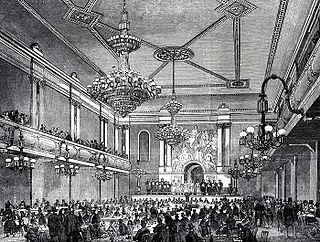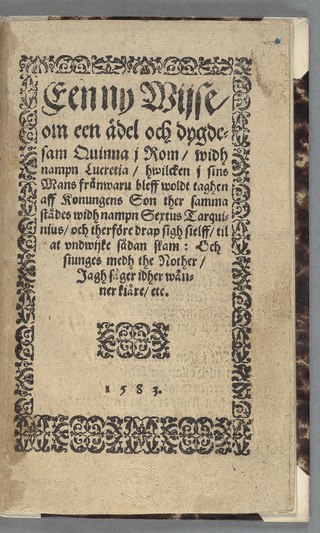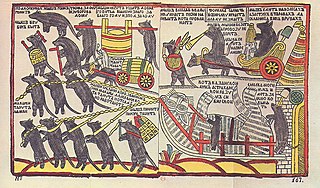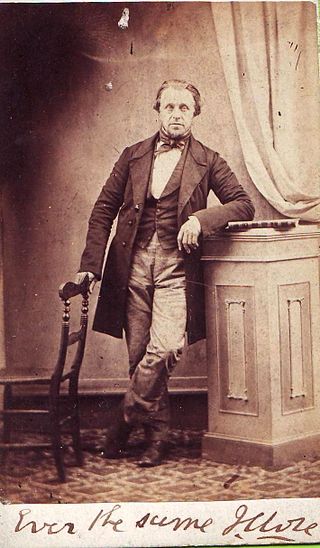
A ballad is a form of verse, often a narrative set to music. Ballads derive from the medieval French chanson balladée or ballade, which were originally "dance songs". Ballads were particularly characteristic of the popular poetry and song of Britain and Ireland from the Late Middle Ages until the 19th century. They were widely used across Europe, and later in Australia, North Africa, North America and South America.

Early British popular music, in the sense of commercial music enjoyed by the people, can be seen to originate in the 16th and 17th centuries with the arrival of the broadside ballad as a result of the print revolution, which were sold cheaply and in great numbers until the 19th century. Further technological, economic and social changes led to new forms of music in the 19th century, including the brass band, which produced a popular and communal form of classical music. Similarly, the music hall sprang up to cater for the entertainment of new urban societies, adapting existing forms of music to produce popular songs and acts. In the 1930s, the influence of American Jazz led to the creation of British dance bands, who provided a social and popular music that began to dominate social occasions and the radio airwaves.

A chapbook is a small publication of up to about 40 pages, sometimes bound with a saddle stitch.

A broadside is a single sheet of inexpensive paper printed on one side, often with a ballad, rhyme, news and sometimes with woodcut illustrations. They were one of the most common forms of printed material between the sixteenth and nineteenth centuries, particularly in Britain, Ireland and North America because they are easy to produce and are often associated with one of the most important forms of traditional music from these countries, the ballad.

A broadside is a large sheet of paper printed on one side only. Historically in Europe, broadsides were used as posters, announcing events or proclamations, giving political views, commentary in the form of ballads, or simply advertisements. In Japan, Chromoxylographic broadsheets featuring artistic prints were common.
"Robin Hood's Progress to Nottingham" is Child ballad 139, an original story that is part of the Robin Hood canon. This song has survived as, among other forms, a late 17th-century English broadside ballad, and is one of several ballads about the medieval folk hero that form part of the Child ballad collection, which is one of the most comprehensive collections of traditional English ballads.
Robin Hood and the Butcher is a story in the Robin Hood canon which has survived as, among other forms, a late seventeenth-century English broadside ballad, and is one of several ballads about the medieval folk hero that form part of the Child ballad collection, which is one of the most comprehensive collections of traditional English ballads. It may have been derived from the similar Robin Hood and the Potter.
Robin Hood's Delight is Child ballad 136. It is a story in the Robin Hood canon which has survived as, among other forms, a late seventeenth-century English broadside ballad, and is one of several ballads about the medieval folk hero that form part of the Child ballad collection, which is one of the most comprehensive collections of traditional English ballads.
Robin Hood and the Bishop is number 143 in Francis James Child's collection of Child ballads, and describes an adventure of Robin Hood. This song has also survived as a late seventeenth-century English broadside ballad, and is one of several ballads about the medieval folk hero that form part of the Child ballad collection, which is one of the most comprehensive collections of traditional English ballads.
Robin Hood and the Shepherd is a story in the Robin Hood canon which has survived as, among other forms, a late seventeenth-century English broadside ballad, and is one (#135) out of several ballads about the medieval folk hero that form part of the Child ballad collection, which is one of the most comprehensive collections of traditional English ballads.
"Robin Hood and the Beggar" is a story in the Robin Hood canon which has survived as, among other forms, a late seventeenth-century English broadside ballad, and is a pair out of several ballads about the medieval folk hero that form part of the Child ballad collection, which is one of the most comprehensive collections of traditional English ballads. These two ballads share the same basic plot device in which the English folk hero Robin Hood meets a beggar.

Popular prints is a term for printed images of generally low artistic quality which were sold cheaply in Europe and later the New World from the 15th to 18th centuries, often with text as well as images. They were some of the earliest examples of mass media. After about 1800, the types and quantity of images greatly increased, but other terms are usually used to categorise them.
The Percy Society was a British text publication society. It was founded in 1840 and collapsed in 1852.
The Cheap Repository Tracts consisted of more than two hundred moral, religious and occasionally political tracts issued in a number of series between March 1795 and 1817, and subsequently re-issued in various collected editions until the 1830s. They were devised by Hannah More and intended for sale or distribution to literate poor people, as an alternative to what she regarded as the immoral traditional broadside ballad and chapbook publications. The tracts proved to be enormously successful with more than two million copies sold or distributed during the first year of the scheme.

John Marshall (1756–1824) was a London publisher who specialized in children's literature, chapbooks, educational games and teaching schemes. He called himself the "Children's Printer" and children his "young friends". He was pre-eminent in England as a children's book publisher from about 1780 to 1800. After 1795, he became the publisher of Hannah More's Cheap Repository Tracts, but a dispute with her led to him issuing a similar series of his own. About 1800 Marshall began publishing a series of miniature libraries, games and picture books for children. After his death in July 1824, his business was continued either by his widow or his unmarried daughter, both of whom were named Eleanor.
James Catnach was an Alnwick-born printer and publisher of the early 19th century. He became a major publisher of chapbooks in the Seven Dials district of London.

John Close, also known as Poet Close, was born on 11 August 1816 at Gunnerside and died at Kirkby Stephen on 15 February 1891. He was an enterprising and prolific writer of working class origin who catered to the English Lake District tourist trade. Of only local significance before 1860, what brought him national notoriety was his being granted and then stripped of a Civil List pension that year.

Robin Hood and Little John is Child ballad 125. It is a story in the Robin Hood canon which has survived as, among other forms, a late seventeenth-century English broadside ballad, and is one of several ballads about the medieval folk hero that form part of the Child ballad collection, which is one of the most comprehensive collections of traditional English ballads.
William Dicey was a newspaper proprietor, publisher of street literature, printseller and patent medicine seller, in Northampton and later in London. He was also the co-founder and proprietor of the Northampton Mercury newspaper from its establishment in 1720 until his death in November 1756. He also built up a huge distribution network in England for patent medicines.
Cluer Dicey was an English newspaper proprietor, publisher of street literature, printseller and patent medicine seller, in London and later in Northampton. He was also proprietor of the Northampton Mercury newspaper from 1756 until his death in October 1775. Likewise he inherited and developed a huge distribution network in England for patent medicines.












